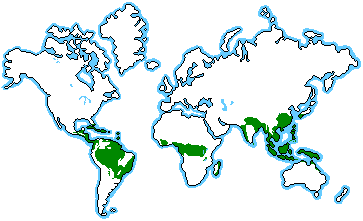Tropical Rainforest Biome (Vanuatu)
Where is it located?

One third of the world's tropical rainforests are located in Brazil. This biome is also found in Southeast Asia, West Africa, Madagascar, and parts of Australia.
Climate
Rain forests belong to the tropical wet climate group. The temperature rarely drops below 20 degrees celcius, or gets higher than 34 degrees celcius.
Average humidity is between 77% and 88%, and rainfall is usually over 100 inches a year. There is usually a brief season which has less rainfall but still has plenty.
Almost all tropical rainforests are close to the equator, which makes sense due to the heat.
Animals
Some of the animals in the Tropical Rainforest are:
emurs, orangutans, jaguars, gorillas, tigers, toucans, butterflies, poisonous frogs, and anteaters.
Animals that live in this biome adapt to their environment by:
Camouflage is a big adaptation that some animals use in the rainforest. Some animals use this ability to hide from predators. For example, the three-toed sloth has green algae on its fur to blend in with the trees.
Predators also use camouflage to sneak up on prey.

Some animals, like the many species of poisonous frogs, have very bright colorful skin that warn other animals not to eat them.

Animals like parrots, can eat food that most other animals cant. They have strong beaks that can help crack the shells of certain nuts.

emurs, orangutans, jaguars, gorillas, tigers, toucans, butterflies, poisonous frogs, and anteaters.
Animals that live in this biome adapt to their environment by:
Camouflage is a big adaptation that some animals use in the rainforest. Some animals use this ability to hide from predators. For example, the three-toed sloth has green algae on its fur to blend in with the trees.
Predators also use camouflage to sneak up on prey.

Some animals, like the many species of poisonous frogs, have very bright colorful skin that warn other animals not to eat them.
Animals like parrots, can eat food that most other animals cant. They have strong beaks that can help crack the shells of certain nuts.
Plants
Many different species of trees and other plant life exist in the rainforest like: lianas, ferns, orchids, stilt roots, bromeliads, fig trees, banyan tree, and coccolobas.
Trees have smooth thin bark due to the high humidity which makes it hard for plants to grow on their surface.
Plants have made adaptations to the large amounts of rainfall by having their leaves be able to shed off water so their branches don't get weighed down and snap.
Leaves on trees need to be very large to absorb as much sunlight as they can in the dark part of the rainforest (understory).
Many trees have buttress and stilt roots for extra support in the shallow, wet soil.
Trees have smooth thin bark due to the high humidity which makes it hard for plants to grow on their surface.
Plants have made adaptations to the large amounts of rainfall by having their leaves be able to shed off water so their branches don't get weighed down and snap.
Leaves on trees need to be very large to absorb as much sunlight as they can in the dark part of the rainforest (understory).
Many trees have buttress and stilt roots for extra support in the shallow, wet soil.
Soil Type
The soil type in the tropical rainforest is shallow, poor in nutrients, and with very few soluble minerals. After thousands of years of heavy rains have washed away these nutrients in the soil. The rainforest doesn't have a long nutrient cycle.
The soil type in the tropical rainforest is shallow, poor in nutrients, and with very few soluble minerals. After thousands of years of heavy rains have washed away these nutrients in the soil. The rainforest doesn't have a long nutrient cycle.
Limiting Factors
There are very few limiting factors that effect tropical rainforests because they do not have harsh environmental or climatic conditions. Since their is very little sunlight on the forest floor due to the big, tall trees, only the toughest of plants can survive, and need to learn to adapt to the dimly lit floor.
Competition for resources between different species can be intense because there are so many different types of organisms that live there.

There are very few limiting factors that effect tropical rainforests because they do not have harsh environmental or climatic conditions. Since their is very little sunlight on the forest floor due to the big, tall trees, only the toughest of plants can survive, and need to learn to adapt to the dimly lit floor.
Competition for resources between different species can be intense because there are so many different types of organisms that live there.

Human Impact
Deforestation is the biggest human impact that effects the tropical rainforests. The amount of deforestation is so large that it could speed up global warming. Niches of many species in the tropical rainforests are endangered because of this as well.
With deforestation happening, humans are building roads, buildings, amd power sources over top of this land, ruining parts of he rainforest for good.
Bibliography
Elizabeth Benders-Hyde 09/23/2010 http://www.blueplanetbiomes.org/rainforest.htm
http://lo2fosho.blogspot.ca/2011/01/limiting-factors-of-tropical-rainforest.html
http://www.geography.learnontheinternet.co.uk/topics/rainforest.html#humans
No comments:
Post a Comment